ONTARIO


ORIGIN OF PROVINCE NAME: Derived from the Iroquois Indian word Kanadario , meaning "sparkling water" or "beautiful lake."
CAPITAL: Toronto.
ENTERED CONFEDERATION: 1 July 1867.
MOTTO: Ut incepit fidelis sic permanet (Loyal it began, loyal it remains).
COAT OF ARMS: In the center, the provincial shield of arms displays in the upper third the cross of St. George (a red cross on a white background) and in the lower two-thirds three gold maple leaves on a green background. Above the shield is a black bear standing on a gold and green bar. Supporting the shield is a brown moose on the left and a brown Canadian deer on the right. Beneath the shield the provincial motto appears.
FLAG: The flag has a red field, with the Union Jack displayed in the upper quarter on the left side and the provincial shield of arms centered in the right half.
FLORAL EMBLEM: White trillium.
PROVINCIAL BIRD: Common loon (unofficial).
TREE: Eastern white pine.
GEMSTONE: Amethyst.
TIME: 7 AM EST = noon GMT; 6 AM CST = noon GMT.
1 LOCATION AND SIZE
Ontario, two times as large as France, covers some 412,579 square miles (1,068,580 square kilometers) and is bordered on the north by Hudson Bay; on the east by Québec; on the south by the St. Lawrence River, the Great Lakes, and the US state of Minnesota; and on the west by Manitoba.
2 TOPOGRAPHY
Three main geological regions make up Ontario: the Great Lakes-St. Lawrence Lowlands, the Canadian Shield, and the Hudson Bay Lowlands. The Hudson Bay Lowlands are narrow coastal plains bordering Hudson Bay and James Bay; the land is wet and covered by scrub growth. The Canadian Shield, covering the rest of northern Ontario from Lake Superior to Hudson Bay, and extending into the southern part of the province, is a vast rocky plateau. Although the soil is poor and not well suited to large-scale farming, there is a wealth of minerals, forests, and water power. The Canadian Shield and the Hudson Bay Lowlands cover 90 percent of the province's territory. Four of the five Great Lakes are the most visible results of the ice age in Ontario, providing the longest fresh water beach in the world. The biggest, Lake Superior, is the world's largest body of fresh water. About 68,490 square miles (177,390 square kilometers), or one-sixth of Ontario's terrain, is covered by some 400,000 lakes and 37,000 miles (59,000 kilometers) of rivers.
The Great Lakes–St. Lawrence Lowlands comprise the rest of southern Ontario. Here is where most of Ontario's population can be found; it is also the area with the most of province's industry, commerce, and agricultural lands.
The short Niagara River, which flows from Lake Erie into Lake Ontario is the site of Niagara Falls (at the Ontario–New York border), which drains some 800,000 gallons (3,000,000 liters) of water per second over its 187-foot (57-meter) drop. The highest point in Ontario is found at Ishpatina Ridge in the Timiskaming District, at an elevation of 2,274 feet (693 meters).
3 CLIMATE
The relatively temperate climate is more severe east of the Great Lakes. Mean annual summer temperatures reach 72° F (22° C ) in the south, where the temperate climate and fertile soils nurture a major agricultural industry. This relatively small area has more than half of Canada's best agricultural land. At Winisk, average daily temperatures reach only 54–59° F (12–15° C ) in July, dropping to -13° F (-25° C ) in January. The warmest recorded temperature in Ontario was 108° F (42.2° C ) on 20 July 1919 at Biscotasing; the coldest recorded temperature was -73° F (-58.3° C ) on 23 January 1935 at Iroquois Falls.
Ontario Population Profile
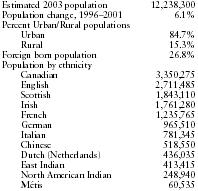
| Estimated 2003 population | 12,238,300 |
| Population change, 1996–2001 | 6.1% |
| Percent Urban/Rural populations | |
| Urban | 84.7% |
| Rural | 15.3% |
| Foreign born population | 26.8% |
| Population by ethnicity | |
| Canadian | 3,350,275 |
| English | 2,711,485 |
| Scottish | 1,843,110 |
| Irish | 1,761,280 |
| French | 1,235,765 |
| German | 965,510 |
| Italian | 781,345 |
| Chinese | 518,550 |
| Dutch (Netherlands) | 436,035 |
| East Indian | 413,415 |
| North American Indian | 248,940 |
| Métis | 60,535 |
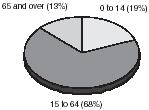
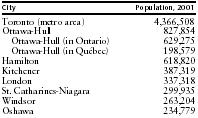
| City | Population, 2001 |
| Toronto (metro area) | 4,366,508 |
| Ottawa-Hull | 827,854 |
| Ottawa-Hull (in Ontario) | 629,275 |
| Ottawa-Hull (in Québec) | 198,579 |
| Hamilton | 618,820 |
| Kitchener | 387,319 |
| London | 337,318 |
| St. Catharines-Niagara | 299,935 |
| Windsor | 263,204 |
| Oshawa | 234,779 |
4 PLANTS AND ANIMALS
The relatively temperate climate of the south is hospitable for a wide variety of
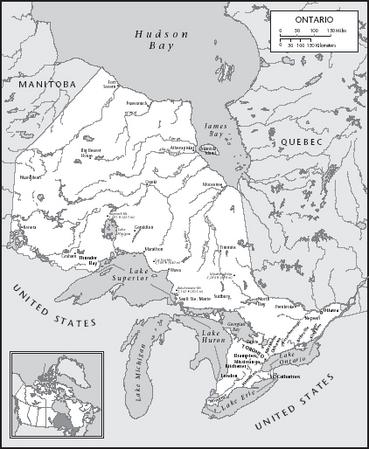
5 ENVIRONMENTAL PROTECTION
The Ministry of Natural Resources (MNR) is responsible for the management of provincial parks, forests, fisheries, wild-life, minerals, and Crown lands and waters, which comprise 87 percent of Ontario's area. The MNR also develops policies on forestry, fisheries, wildlife, parks, and land and water issues. These policies aim to sustain Ontario's natural resources for future generations. The MNR has helped create several partnership arrangements in resource management that show to the public the social costs and benefits of resource development. Some of these partnerships include the Wildlife Working Group, the Strategic Plan for Ontario Fisheries, and the Forest Management Agreements. Ontario's Chapleau Game Preserve is the largest in the world.
For decades, tons of sulfur dioxide and other chemicals have been put into the air by factories in the American Midwest. Prevailing winds carry the toxins northward across Ontario, Québec, and the northeastern United States. As a result, poisonous rainclouds have released acidic rain on the lands and lakes to the north. Hundreds of lakes in Ontario became severely damaged; forests and farms were affected as well. By 1980, the damage from acid rain across northeastern Canada was extensive.
In 2000, Ontario disposed of 7,615,923 metric tons of municipal, construction, and demolition waste. This was equivalent to 1,433 pounds (650 kilograms) of waste per person.
6 POPULATION
With a 2001 population of 11.4 million people, Ontario is Canada's most heavily populated province, with over one-third of the country's total population. The Canadian Shield and the Hudson Bay Lowlands cover 90 percent of the province's territory, but are home to only 10 percent of Ontario's population. Toronto, Ontario's capital and Canada's largest city, had a population of 4.37 million in 2001. Ottawa, the bilingual, bicultural national capital, sits at the junction of the Gatineau, Rideau, and Ottawa Rivers; together with Hull, Québec, the metropolitan population in 2001 was 1.03 million. Other cities and their 2001 populations include: Hamilton 618,820; Kitchener, 387,319; London, 337,318; St. Catharines–Niagara, 299,935; Windsor, 263,204; Oshawa, 234,779; Barrie, 129,963; and Kingston, 108,158.
7 ETHNIC GROUPS
About 42 percent of Ontario's population is of British origin, and many individuals
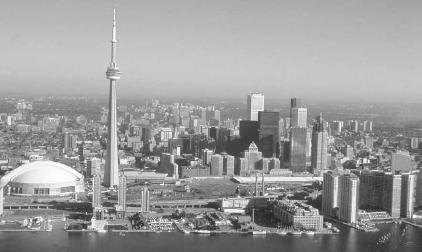
In 2001, Ontario had approximately 309,475 people of Aboriginal (native) or Métis origin. Six Nations of the Grand River, which consists of 13 different groups, has the largest native band in Canada.
8 LANGUAGES
In 2001, English was the mother tongue of 70.6 percent of Ontario's residents, while French was the primary language of 4.3 percent of Ontarians and 23.7 percent had other first languages (1.4 percent had two or more native languages). English is the only official language, but Ontario's French speakers play an essential part in the province's cultural life and are the largest language minority The provincial government provides services in French in the regions where the French-speaking population is sufficiently high. Toronto has more Italian speakers than any city outside of Italy.
9 RELIGIONS
About 35 percent of the population, or approximately 3,935,745 people, are Protestant, the majority of whom are members of the United Church of Canada or Anglicans, but there are significant numbers of Presbyterians, Baptists, Lutherans, and Pentecostals. Ontario also has about 3,911,760 Catholics, who make up 34.7 percent of the population. There are about 264,055 people of Eastern Orthodox faith, 352,530 Muslims, 190,795 Jews, 217,555 Hindus, 128,320 Buddhists, and 104,785 Sikhs. Some 1,841,290 provincial residents profess no religious affiliation.
10 TRANSPORTATION
Northern Ontario's towns were built because of the railway, and today rails and roads carry the products of the mines and mills southward. Farther north, travel is often limited to air and water.
In 2003, Ontario had 6,957,174 registered motor vehicles, 28,179 registered buses, 112,567 registered motorcycles and mopeds, and 1,677,810 registered trailers.
Ontario has 61 commercial ports. Access to the Great Lakes and the St. Lawrence Seaway helps make waterborne traffic an important part of the province's transportation system.
Public transportation is well-developed in the metropolitan Toronto area. Toronto Transit operates the subway system, with streetcar and bus service available as well. The provincial government operates the GO (Government of Ontario) commuter train service, connecting Toronto to Richmand Hill, Georgetown, and Bradford in the north; to Whitby in the east; and to Hamilton in the west. Urban transit consists of over 4,600 buses operated by about 50 establishments. There are also some 300 trolley coaches and light-rail vehicles each, and over 600 heavy rail vehicles.
International air service is available from Ottawa as well as Pearson International Airport in Toronto. Pearson is a hub for Air Canada, and is one of the biggest international aviation facilities in Canada.
11 HISTORY
Ontario surrounds the Great Lakes. Sailing into the large bay that bears his name, Henry Hudson became the first European to reach the shores of present-day Ontario in 1610. Three years later, in 1613, Samuel de Champlain and Étienne Brûlé made the first contacts with the aboriginal, or native, people in the southern part of the province.
In 1774 the British ruled over southern Ontario, which was then part of the British colony of Québec. Under the Constitutional Act of 1791, "Québec" was divided in two, and Ontario became Upper Canada. This area was populated by a large number of Loyalists (American colonists who had sided with Great Britain) after the American Revolution. In 1840, the Act of Union reunited Upper and Lower Canada, this time under the name Canada. When the Dominion of Canada was created in 1867, the region was split into the separate provinces of Ontario and Québec.
The new province of Ontario developed slowly until the launch of large-scale industry in the early 1900s. In the space of three years between 1903 and 1906, the Ford Motor Company started to manufacture
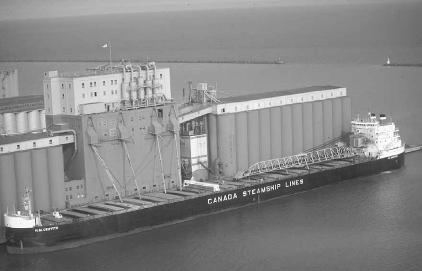
Canada experienced losses of over 68,000 soldiers in World War I (1914-1918), and veterans returning to Ontario faced a bleak future of scarce, low-paying jobs. At the same time, tariffs (taxes) on imports kept prices for consumer goods high. Overall, Canada experienced a period of rapid industrialization in the 1920s. Improvements were made to railways and roads, and this helped trade to flourish. Automobiles, telephones, electrical appliances, and other consumer goods became widely available. Consumer confidence led to the rapid expansion of credit, which allowed businesses to grow. Ontario's farmers had prospered during the war, but by 1920 wheat prices had fallen by 50%. Farmers organized the powerful United Farmers Movement in Ontario to protest low farm product prices and high transportation rates.
During the 1920s, grain prices rose and heavy industry developed across southern Ontario. In fact, almost half of Canada's manufacturing output came from Ontario at this time. Automobiles, telephones, electrical appliances, and other consumer goods became widely available. As in the United States, consumer confidence led to the rapid expansion of credit, which created even more business opportunities.
Prosperity suddenly ended in 1929 with the start of the Great Depression, a period of extreme economic slowdown. All of Canada suffered greatly, and in Ontario, the pulp and paper industry in the North was particularly hard hit. On the agricultural front, in addition to the problems with grain prices during the early 1920s, droughts and frequent crop failures devastated the national economy, which still heavily relied on agriculture. Social welfare programs rapidly expanded during the 1930s to help the citizens of Canada during this rough economic period.
Economic Expansion in Ontario
World War II (1939–1945) brought both the United States and Canada out of the depths of the Depression. Following the war, Ontario's economy expanded. Prosperity increased as more and more people immigrated to Ontario from the United Kingdom, Germany, and Italy. Many of these immigrants settled in Toronto. Urbanization spread quickly as a result of the National Housing Act, which made it easier for people to own their own homes. As cities expanded, farmland—especially between Toronto and Niagara Falls—began to disappear.
Ontario's railways, seaways, and roads became top priorities in the 1950s and 1960s. In 1954 in Toronto, Canada's first subway system opened. With the completion of the St. Lawrence Seaway five years later, ocean-going ships were allowed access to southern and western Ontario through the Great Lakes. Thousands of kilometers of highways were also built, particularly in the area along Lake Ontario's western shore down to the Canadian-U.S. border. Highway 401, which stretches across southern Ontario, opened in 1968 and quickly became one of the busiest highways in Canada.
Ontario's economic expansion continued during the 1960s and 1970s. The provincial government spent more money on health and education, and a large number of universities opened during this period. In 1967, a new community college system was established. Soon, Toronto became the financial center of all of Canada. In 1976, Toronto also became home to the world's tallest building with the completion of the CN Tower.
Events Since the 1980s
The 1980s and 1990s saw a number of firsts in Ontario history: 1) In 1985, Liberal Party member David Peterson became Ontario's Premier, a post that had been held by Progressive Conservatives for more than 40 years. 2) In 1991, Ontario's population reached 10 million. 3) Ontario native Roberta Bondar became Canada's first woman in space in 1992. 4) That same year, Canada joined the US and Mexico in signing the North American Free Trade Agreement (NAFTA), which was built upon the U.S.-Canada Free Trade Agreement. NAFTA, which was implemented in 1994, seeks to create a single market of 370 million people. The agreement was expected to boost
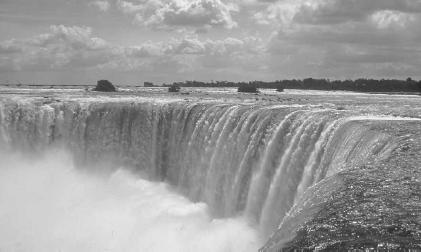
By 1995, the Progressive Conservative Party had returned to power in Ontario under the leadership of Mike Harris. His "Common Sense Revolution" had its supporters, but there was also resistance that led to protests, riots, and massive labor strikes. In addition, Harris was blamed for the tainted-water tragedy in Walkerton, Ontario, that occurred in 2000. The mishap, which led to the deaths of seven people and the illness of many more, was attributed to Conservative cuts to Ontario's Environment Ministry. Mike Harris stepped down as premier of Ontario on 23 March 2002.
Same-sex marriages were legalized in Ontario in June 2003. As of 2004, a federal bill to formally legalize same-sex marriages in Canada was under consideration.
Severe acute respiratory syndrome (SARS) was first recognized in Toronto in a woman who had returned from Hong Kong on 23 February 2003. Transmission to others subsequently led to an outbreak among 257 people in the greater Toronto area. On 22 April 2003, the World Health Organization (WHO) issued a travel advisory to Toronto. The advisory was lifted on 30 April. Between 23 February and 7 June, the Ontario Ministry of Health and Long-Term Care received reports of 361 SARS cases.
On 14 August 2003, a massive blackout struck Ontario and parts of the Midwest and Northeast in the U.S. Power was severed for 50 million people from Detroit to Toronto and Ottawa to east of New York. Ten million people in Ontario were affected. Ontario premier Ernie Eves declared a state of emergency. His handling of the crisis was criticized, and the government fell in October. (He was replaced as premier by Dalton McGuinty.) By 15 August, Ontario Hydro had reestablished 75 percent of the power in the province, although rolling blackouts were still occurring. In Ottawa, looting and two deaths (a pedestrian hit by a car and a fire victim) resulted from the crisis. It was estimated that the blackout would cost Ontario C $550 million.
12 PROVINCIAL GOVERNMENT
The structure of the provincial government reflects that of the federal government. For example, the provincial premier, as the majority party leader of the legislature, functions much like the Canadian prime minister. Provincial legislators, like their federal counterparts in Parliament, are elected to represent a constitutional jurisdiction and pass legislation. They do so as members of the 103-seat Legislative Assembly. A provincial lieutenant-governor approves laws passed by the legislature, much like the Governor General at the federal level. There is no provincial equivalent, however, to the federal Senate.
13 POLITICAL PARTIES
The Liberal Party was the principal political group in the 1800s, and held power continuously from 1848 to 1905. After 1905, the Conservative Party dominated, reaching a high point in 1929 by winning 92 of 112 seats. During the late 1910s and early 1920s, the United Farmers of Ontario (UFO) controlled a considerable minority of seats. After 1943, the province began to see three parties vie for power; from the 1940s to 1960s, the Co-operative Commonwealth Federation (CCF) and later the New Democratic Party (NDP) irregularly won control over a sizable minority of seats. Finally in 1990, the NDP won control of the Legislative Assembly.
The most recent general election was held in 2003. The parties held the following number of seats in Ontario's Legislative Assembly: Progressive Conservative Party, 24; Liberal Party, 72; and New Democratic Party, 7.
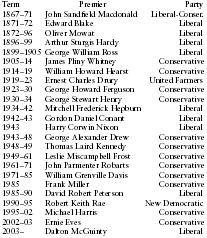
| Term | Premier | Party |
| 1867–71 | John Sandfield Macdonald | Liberal-Conser. |
| 1871–72 | Edward Blake | Liberal |
| 1872–96 | Oliver Mowat | Liberal |
| 1896–99 | Arthur Sturgis Hardy | Liberal |
| 1899–1905 | George William Ross | Liberal |
| 1905–14 | James Pliny Whitney | Conservative |
| 1914–19 | William Howard Hearst | Conservative |
| 1919–23 | Ernest Charles Drury | United Farmers |
| 1923–30 | George Howard Ferguson | Conservative |
| 1930–34 | George Stewart Henry | Conservative |
| 1934–42 | Mitchell Frederick Hepburn | Liberal |
| 1942–43 | Gordon Daniel Conant | Liberal |
| 1943 | Harry Corwin Nixon | Liberal |
| 1943–48 | George Alexander Drew | Conservative |
| 1948–49 | Thomas Laird Kennedy | Conservative |
| 1949–61 | Leslie Miscampbell Frost | Conservative |
| 1961–71 | John Parmenter Robarts | Conservative |
| 1971–85 | William Grenville Davis | Conservative |
| 1985 | Frank Miller | Conservative |
| 1985–90 | David Robert Peterson | Liberal |
| 1990–95 | Robert Keith Rae | New Democratic |
| 1995–02 | Michael Harris | Conservative |
| 2002–03 | Ernie Eves | Conservative |
| 2003– | Dalton McGuinty | Liberal |
14 LOCAL GOVERNMENT
The populous regions of southern Ontario are divided into counties and regional municipalities. Cities and towns within counties are not under the jurisdiction of county governments. Restructured municipalities have over 60 percent of Ontario's population and contain fewer but larger incorporated municipalities than those of the counties. Restructured units provide more extensive services than do counties, such as water supply, sewage treatment, waste management, regional planning, social services, long-term financing, and police services.
Northern Ontario is divided into 11 territorial districts. The far northern parts of Ontario are not organized into any municipal units.
15 JUDICIAL SYSTEM
The Canadian Constitution grants provincial jurisdiction over the administration of justice, and allows each province to organize its own court system and police forces. The federal government has exclusive domain over cases involving trade and commerce, banking, bankruptcy, and criminal law. The Federal Court of Canada has both trial and appellate divisions for federal cases. The nine-judge Supreme Court of Canada is an appellate court that determines the constitutionality of both federal and provincial statutes. The Tax Court of Canada hears appeals of taxpayers against assessments by Revenue Canada.
The provincial court system consists of the Ontario Court of Justice, the Superior Court of Justice, and the Court of Appeal, which is Ontario's highest appeals court. There is a small claims court, and there are family courts as well.
In 2002, there were 178 homicides in Ontario. That year, there were 829 violent crimes per 100,000 persons, and 3,231 property crimes per 100,000 persons.
16 MIGRATION
Ontario's first immigrants arrived about 10,000 years ago, during the last ice age. The European explorers encountered the Iroquois and Algonquin descendants of those first migrants in the 17th century. From 1779 on, waves of English, Scottish, and Irish immigrants followed one another, moving up the St. Lawrence and populating the country. Today, immigration continues to be important to Ontario, and there are large numbers of people of Italian, German, Chinese, Dutch, Portuguese, Indian, and Polish origin.
In 2001, there were 3 million immigrants living in Ontario (the majority in Toronto). The leading places of birth were the United Kingdom, 11.3 percent; Southern Europe, 16 percent; East Asia (mostly from China), 11.5 percent; Southern Asia (mostly from India), 10.7 percent; Eastern Europe, 9.5 percent; and Southeast Asia (mostly from the Philippines), 7.5 percent. Many immigrants in recent years have also come from Italy.
In 2001, 4.9 percent of Ontario's residents age 5 and older were living abroad. Some 12.5 percent were living elsewhere in Ontario, while 2.3 percent were living in another province. As Canada's most populous province, Ontario is both the primary origin and primary destination for internal migration. Québec is the leading province of origin for people entering Ontario from other provinces; British Columbia is the principal destination for Ontarians leaving to live elsewhere in Canada.
17 ECONOMY
Ontario is Canada's most productive province, having generated C $478.1 billion of the country's gross domestic product (GDP) in 2002, or about 41.4 percent of the national total. The main industries are manufacturing, finance, construction, tourism, agriculture, and forestry.
18 INCOME
The average family income was C $76,891 in 2000 for a family of five. This was the second highest average family income among the provinces, behind the NWT. Average weekly earnings in 2000 were C $669.21.
19 INDUSTRY
Beginning in the 1880s, industrial corporations in Ontario became larger, and farming was no longer the province's largest sector of employment. Toronto is Canada's leading producer of manufactured goods. In 2002, Ontario produced 54 percent of Canada's manufactured goods. Manufacturing employs about 20 percent of the total work force. The headquarters of a large number of Canadian companies are also found in Toronto. In 2003, manufacturing accounted for 21.5 percent of Ontario's gross domestic product (GDP).
Automobiles are Ontario's major manufacturing industry and are its most important export. In 1964, the federal governments of Canada and the United States negotiated the Canada–United States Automotive Agreement (also known as the Auto Pact), an agreement that permitted the free trade of automotive parts and vehicles between the two countries. As a result, Ontario's automotive industry expanded through the mid-1970s. The auto industry now employs 140,000 people and provides about 43 percent of Ontario's foreign exports. Ontario produces every sixth vehicle built in North America per year. It is the second most important vehicle producing region in North America after Michigan. Eight leading car and truck manufacturers have 13 plants in 8 Ontario locations. They are among the most cost competitive in the world.
In 2002, the value of manufactured shipments totaled C $277.6 billion. Leading manufacturing industries are transportation equipment, food products, chemicals and chemical products, electrical and electronic products, fabricated metal products, and primary metal products.
20 LABOR
In 2003, Ontario's labor force consisted of 4 million people. That year, the unemployment rate was 8.7 percent. There were 3.69 million persons employed, and 353,900 persons unemployed. The hourly minimum wage as of January 2004 was C $6.85.
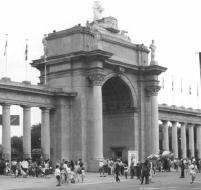
The sectors with the largest number of employed persons in 2003 were manufacturing, 1,079,800; trade, 934,800; health care and social services, 619,300; finance, insurance, and real estate and leasing, 432,000; professional, scientific, and technical services, 427,100; construction, 396,300; educational services, 389,700; accommodation and food services, 370,100; public administration, 315,400; information, culture, and recreation, 298,700; transportation and warehousing, 286,900; management, administrative, and other support, 274,100; other services, 250,600; agriculture, 87,400; utilities, 58,200; and forestry, fishing, mining, and oil and gas, 30,000.
21 AGRICULTURE
In 2001, Ontario had 59,728 farms, the highest number among the provinces. That year, the total land area of farms in Ontario was 13.5 million acres (5.5 million hectares), of which 9.04 million acres (3.7 million hectares) were under crops. Farm receipts in 2000 (excluding forest products sold) amounted to C $9.12 billion, or 23.8 percent of the national total. Farmers' operating expenses in 2000 equaled C $7.83 billion. The average farmer was left with C $21,437 before interest payments and taxes.
The primary field crops in 2001 were soybeans, fodder corn, alfalfa, other hay, and winter wheat. Some 15 wineries in the Niagara Peninsula have produced wines of international acclaim; 80 percent of the national wine production comes from this area.
The top three fruit products produced are apples, grapes, and peaches. The top three field-grown vegetables produced are sweet corn, green peas, and tomatoes. A total of 405 farms were growing certified organic products in 2001. Over 2,000 farms had greenhouses under glass, plastic, or other protection. There were 1,443 farms producing nursery products, 135 sod farms, and 918 farms producing Christmas trees in 2001.
22 DOMESTICATED ANIMALS
Ontario has over 30,000 livestock farms. Livestock farms cover some 2.5 million acres (1.04 million hectares) of pasture land. The livestock population in 2001 included 2.14 million head of cattle, 363,544 dairy cows, 3.46 million pigs, and 337,625 sheep. The poultry population in 2003 was 11.58 million. There were 1,150 chicken producers, 157 turkey producers, and 421 egg producers. Livestock receipts in 2003 were C $4.63 billion.
23 FISHING
Ontario has about 1,500 registered freshwater commercial fishers who operate mainly on the Great Lakes. Aquaculture (fish farming) is increasingly important, especially the raising of trout. In 2003, 18,675 tons of fish, valued at C $104.9 million, were exported from Ontario.
Sport fishing is a popular activity on Ontario's rivers and lakes. In 2000, 814,887 Ontario residents were actively engaged in sport fishing within the province.
24 FORESTRY
In 2002, Ontario had 143.3 million acres (58 million hectares) of forest land, of which provincial ownership accounted for 88 percent; private lands, 11 percent; and federal areas, 1 percent. The provincial government licenses logging rights. In 2000, the timber harvest was 436,564 acres (176,668 hectares). Principal timber species include spruce, poplar, birch, pine, and maple. There are over 2,400 logging, wood processing, and paper manufacturing establishments in the province—many Ontario towns have at least one industry connected to forestry. In 2002, Ontario exported C $9.3 billion in forestry products, mainly paper and paperboard, news-print, wood pulp, and softwood lumber.
In 2001, Ontario's 918 Christmas tree farms covered 21,765 acres (8,808 hectares).
25 MINING
The principal minerals and metals produced in Ontario are gold, nickel, copper, zinc, cobalt, salt, stone, cement, and sand and gravel. About 14,000 were employed in mining in 2002. The first metal mine in Canada started mining copper ore in 1850 on the north shore of Lake Huron. The Creighton nickel and copper mine in Sudbury is the deepest mine in Canada, reaching a depth of about 7,200 feet (2,200 meters). Thunder Bay has the largest open pit gemstone mine in North America; all types of amethyst are found there.
In 2003, the value of mineral production was C $5.54 billion (highest in Canada), of which metals accounted for roughly 59 percent, and industrial minerals, 41 percent. The value of mineral fuels was negligible. That year, gold accounted for 22.6 percent of the value of Ontario's mineral production, nickel for 21.5 percent, cement for 11 percent, stone for 9 percent, sand and gravel for 7.4 percent, and copper for about 7 percent. Approximately 40 percent of Canadian sand and gravel is produced in Ontario.
26 ENERGY AND POWER
In the 1890s, Canada began large-scale development of its hydroelectric potential, with generators and transmission lines constructed at Niagara Falls, Ontario.
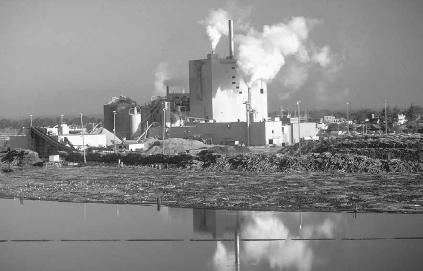
As of 2004, nuclear power represented almost half of Ontario's electricity output. The Bruce Nuclear Power Station in Bruce Township opened in 1967 as Canada's first nuclear power-generating plant, and became fully operational in 1969. In 1997, Ontario Hydro, formerly the largest utility in North America, authorized the shutdown and overhaul of 7 of its 19 reactors because the company judged that it did not have the money or personnel needed to run them safely. The units have a simpler design than reactors built in the United States, but are more difficult to keep running safely.
Ontario is Canada's leading petroleum refining region. The province has five refineries with an annual capacity of 170 million barrels (27 million cubic meters). The province is self-sufficient in petroleum products, and exports them to other provinces and the US as well.
Natural gas is the major fuel for all sectors of the economy except transportation. It is used in residential, commercial, and industrial heating. Industry is looking to natural gas to reduce greenhouse gas emissions.
Electrical power in Ontario is relatively inexpensive. Ontario opened its electricity market to competition in May 2002. The former Ontario Hydro was broken up into successor companies, including Ontario Power Generation (OPG) and Hydro One. OPG generates about 75 percent of the electricity in the province. Hydro One distributes electricity to rural and remote communities.
27 COMMERCE
In 2002, total exports in Ontario amounted to C $206.5 billion and imports totaled C $224.6 billion. The United States is Ontario's major export market (93.4 percent of all exports) and major import supplier (72.5 percent of all imports). Other export markets are the United Kingdom, Mexico, China, and Japan. Import suppliers include Mexico, China, Japan, and Germany.
Southern Ontario's heavy population density makes the region the most commercially active in Canada for supermarkets, motor vehicle dealers, general merchandise stores, and gasoline service stations. Ontario's proximity to key US markets puts the province's products less than a day's drive away from a large portion of American consumers.
28 PUBLIC FINANCE
The fiscal year runs from 1 April to 31 March. For fiscal year 2002/03, total revenues were estimated at C $66.39 billion; expenditures totaled C $65.39 billion. The largest expenditure areas were health, social services, education, interest on debt, and colleges and universities. In the 2002/03 fiscal year, provincial debt was estimated at 21.1 percent of the gross domestic product, or C $110.19 billion.
29 TAXATION
The basic personal income tax rate in 2003 was 47.2 percent, with high income surtaxes of 20–36 percent. The retail sales tax was 8 percent. Major consumption taxes are levied on gasoline ( C $0.147 per liter) and tobacco ( C $17.20 per carton).
The average family of four (two parents and two children) in 2003 earned C $89,100. Such a family paid C $40,117 in taxes.
Corporate income tax rates in 2003 were as follows: small business rate, 5.5 percent; manufacturing and processing corporate rate, 11 percent; general business rate, 12.5 percent; and capital tax rate, 0.3–0.9 percent.
30 HEALTH
In 2001, there were 131,709 live births in Ontario, an increase of 3.4 percent over 2000. Ontario was one of only four provinces or territories that had an increase in the number of live births in 2001. There were 81,214 deaths that year, a 0.1 percent decrease from 2000. Life expectancy for men in 2001 was 77.5 years, and 82.2 years for women. Reported cases of selected diseases in 2002 included gonococcal infections, 3,006; campylobacteriosis, 4,569; salmonellosis, 2,455; giardiasis, 1,870; and type B hepatitis, 132. Between November 1985 and June 2003, 22,784 residents had become infected with HIV, the virus that causes AIDS.
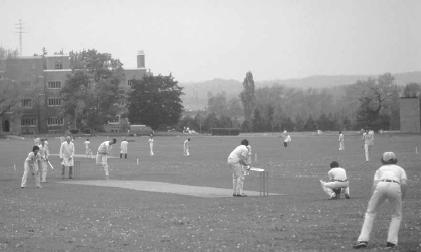
31 HOUSING
Ontario had 4,219,410 households in 2001, with an average size of 2.7 persons. There were 2,447,800 households living in single-detached houses, 678,325 households living in apartments in buildings with five or more stories, 12,375 households living in mobile homes, and 1,080,915 households living in other dwellings, including row houses and apartments in buildings with fewer than five stories. In 2002, C $22.1 billion was invested in residential housing construction. In 2003, housing starts reached their highest level in 14 years, up 1.9 percent from 2002.
32 EDUCATION
In 2000, Ontario had nearly 2.2 million students enrolled in its elementary and secondary schools. Of the 9 million people age 15 and older, 2.6 million have less than a high school diploma, 2.3 million are high school graduates, 1.4 million have a two-year college certificate, and 1.8 million have a college degree.
In November 1997, Ontario's teachers' unions held a two-week strike. It was the largest teachers' strike ever in North America.
The University of Toronto, founded in 1827, is the largest university in Canada, with about 37,000 full-time undergraduate and graduate students as of 2004. Other universities in Ontario (with location and year founded) include York University (North York, 1959); University of Western Ontario (London, 1878); University of Waterloo (1957); University of Guelph (1964); University of Ottawa (1848); Carleton University (Ottawa, 1942); Queen's University (Kingston, 1841); McMaster University (Hamilton, 1887); Ryerson Polytechnical Institute (Toronto, 1948); University of Windsor (1857); Brock University (St. Catharines, 1964); Laurentian University (Sudbury, 1960); Lakehead University (Thunder Bay, 1965); Trent University (Peterborough, 1963); and the Royal Military College of Canada (Kingston, 1876).
College tuition has always been regulated by the provincial governments, largely because it has been heavily subsidized by taxpayers. In 1996, the Ontario government deregulated foreign student tuition, allowing schools to set their own fees. After the deregulation, several universities in the province began to market aggressively for American students, enticing them with low tuition rates due to the strength of the US dollar. Average annual university tuition in Ontario was $5,000 in 2003, compared to $2,100 in 1993.
33 ARTS
Toronto is well-known for its impressive theatrical productions, which have included The Phantom of the Opera and Miss Saigon in the past, and Mamma Mia and The Producers in 2004. More than 100 professional companies perform plays, cabaret, opera, and dance in Toronto. The Toronto Symphony Orchestra is Canada's foremost symphonic ensemble. More than 400,000 patrons visit the Orchestra each year, and an additional 5 million Canadians listen to its broadcasts on CBC Radio. Toronto also boasts North America's largest film festival which is held each year in September. Ontario's over 100 performing arts companies give 13,000 performances before a total attendance of 5 million each year. In 2000/01, however, per capita provincial spending on the arts in Ontario was C $45, the lowest amount among the provinces and territories. Municipal spending on the arts was C $58 per person, and federal spending on the arts in Ontario was C $98 per person, slightly higher than the national average of C $96.
34 LIBRARIES AND MUSEUMS
The Metropolitan Toronto Reference Library is Canada's largest public library, with more than 4 million items in its collections. There are more than 50 public libraries focusing on the province's First Nations (native people, including Métis, and Inuits). The National Library of Canada is in Ottawa.
The Royal Ontario Museum in Toronto is Canada's largest, with over 6 million examples of works of art, artifacts, and scientific treasures. Toronto also has the Art Gallery of Ontario, which houses over 15,000 paintings, prints, drawings, and sculptures, including the world's largest public collection of Henry Moore sculptures. Other museums in Toronto include the Bata Shoe Museum, Canada's Sports Hall of Fame, and the Hockey Hall of Fame. The Ontario Science Centre in North York has popular educational hands-on exhibits. Ottawa has many national museums, including the Canadian Museum of Contemporary Photography, the National Gallery of Canada, the Canadian War Museum, the Canadian Museum of Nature, the National Museum of Science and Technology, the Agricultural Museum, and the National Aviation Museum.
35 COMMUNICATIONS
Toronto is the headquarters of several broadcasting and cable networks, including the Canadian Broadcasting Corporation, the Canadian Television Network, the Family Channel, First Choice, Much Music, The Sports Network, Vision TV, and the Youth Channel.
36 PRESS
Nearly 50 daily newspapers are published in Ontario. Those published in Toronto include The National Post , The Toronto Sun , The Toronto Star , The Financial Post , The Globe and Mail, The Korea Times (in Korean), and El Popular (in Spanish). Ottawa's three daily newspapers are Le Droit (French-language), The Ottawa Citizen , and the Ottawa Sun . International Thomson, a multinational publishing corporation, is headquartered in Toronto and is Canada's largest media company.
37 TOURISM, TRAVEL, AND RECREATION
Tourism is an important sector of the Ontario economy. In 2001, tourists generated about C $19.4 billion in total revenue for the province and more than 261,700 direct jobs. A total of 129.8 million people visited Ontario in 2002.
Toronto's Canadian National Exhibition, with crafts and exhibits from around the world, draws thousands of tourists every August. Its Symphony of Fire is the largest fireworks display in the world, while the Caribana is the world's largest Caribbean festival. Ottawa annually holds the largest tulip festival in the world, and Fergus is the site of the biggest Scottish festival in North America.
38 SPORTS
The Sky Dome, the world's first stadium with a completely retractable roof, is the home of Major League Baseball's Toronto Blue Jays, who in 1992 became the first Canadian team to win the World Series. The Blue Jays were baseball's champions again in 1993. Ontario has two teams in the National Hockey League (NHL): the Toronto Maple Leafs and the Ottawa Senators. The Maple Leafs were the Stanley Cup winners in 1932, 1942, 1945, 1947–49, 1951, 1962–64, and 1967; the Senators won it in 1909, 1911, 1920, 1921, 1923, and 1927. The Canadian Football League (CFL) fields three teams in Ontario: the Hamilton Tiger-Cats, CFL champions in 1957, 1963, 1965, 1967, 1972, 1986 and 1999; the Toronto Argonauts, CFL champions in 1983, 1991, 1996, and 1997; and the Ottawa Renegades, who began CFL play in 2001.
Women's hockey has grown in popularity and is played extensively in Ontario. The National Women's Hockey League

Ontario has more than 500 public golf courses; the only Professional Golf Association (PGA) Tour event outside the United States is held near Toronto. Kenora's Lake of the Woods Regatta in August is the largest freshwater sailing regatta in the world. Snowmobiling across the province's 21,000 miles (33,800 kilometers) of snowmobile trails is a popular winter activity.
39 FAMOUS ONTARIANS
Ontarians Sir John A. Macdonald (b.Scotland, 1815–91) and Alexander Mackenzie (b.Scotland, 1822–92) served as Canada's first and second prime ministers, respectively. Other prime ministers native to Ontario have included Arthur Meighen (1874–1960), Mackenzie King (1874–1950), John Diefenbacker (1895–1975), and Lester Pearson (1897–1972), who received the Nobel Peace Prize in 1957.
Military figures include General Sir Arthur Curiae (1875–1933), Canadian infantry commander in World War I, and the World War I flying ace Roy A. Brown (1893–1944), who is credited with shooting down Captain Manfred von Richthofen ("the Red Baron"), Germany's leading war hero, on 21 April 1918.
Ontario has been the birthplace of many prominent figures in entertainment and the arts, including actors and actresses Mary Pickford (b.Gladys Smith, 1893–1979), Cecilia Parker (1909–93), Robert Beatty (1909–92), Hume Cronyn (1911–2003), Lou Jacobi (b.1913), Lorne Greene (1915–87), Ann Rutherford (b.1917), Don Harron (b.1924), John Colicos (b.1928), Christopher Plummer (b.1929), Eugene Levy (b.1946), Phil Hartman (1948–98), John Candy (1950–94), Kate Nelligan (b.1951), Dan Aykroyd (b.1952), Rick Moranis (b.1953), Hart Bochner (b.1956), Jim Carrey (b.1962), and Mike Myers (b.1963); directors David Cronenberg (b.1943) and Norman Jewison (b.1926); comedians Frank Shuster (1916–2002), Rich Little (b.1938), Martin Short (b.1950), and Howie Mandel (b. 1955); musicians and singers Teresa Stratas (b.1938), Gordon Lightfoot (b.1938), Sylvia Tyson (b.1940), Paul Anka (b.1941), Neil Young (b.1945), Geddy Lee (b.1953), Dan Hill (b.1954), and Jeff Healey (b.1966); pianist Glenn Gould (1932–82); classical guitarist Liona Boyd (b.England, 1949); big band leader Guy Lombardo (1902–77); artists Frank Carmichael (1890–1945), Jack Bush (1909–77), and Ken Danby (b.1940); prima ballerinas Melissa Hayden (b.1923) and Karen Kain (b.1951); broadcasters and journalists Knowlton Nash (b.1927), Morley Safer (b.1931), Barbara Frum (1938–92), and Peter Jennings (b.1938); and television host Alex Trebek (b.1940).
Noted Ontarian authors include novelists Morley Callaghan (1903–90), Robertson Davies (1913–95), Elizabeth Smart (1913–86), Timothy Findley (b.1930), Howard Engel (1933–85), Sylvia Fraser (b.1935), Matt Cohen (1942–99), and Joan Barfoot (b.1946); playwrights Mazo De la Roche (1879–1961), James Reaney (b.1926), and Paul Quarrington (b.1953); humorist and historian Stephen Leacock (b.England, 1869–1944); children's author Dennis Lee (b.1939); "subjective nonfiction" writer Farlay Mowat (b.1921); short story writer Alice Munro (b.1931); poets Pauline Johnson (1861–1913), John McCrae (1872–1918), Al Purdy (1918–2000), David Helwig (b.1938), Margaret Atwood (b.1939), Gwendolyn MacEwen (1941–87), and M. T. Kelly (b.1946); and writer/journalists June Callwood (b.1924), and Silver Donald Cameron (b.1937).
Famous Ontarians in science include physiologist Sir Frederick Grant Banting (1891–1941), who received the 1923 Nobel Prize in medicine for his codiscovery of insulin. Alexander Graham Bell (b.Scotland, 1847–1922), inventor of the telephone, was raised in Brantford.
James Naismith (1861–1939), inventor of basketball, was born in Almonte. Hockey stars from Ontario include Frank Selke (1893–1985), Leonard Patrick ("Red") Kelly (b.1927), Alex Peter Delvecchio (b.1931), Robert Marvin "Bobby" Hull Jr. (b.1939), Ed Giacomin (b.1939), Barclay Plager (1941–89), Phil Esposito (b.1942), Robert "Bobby" Orr (b.1948), Douglas Bradford "Brad" Park (b.1948), Larry Clark Robinson (b.1951), and Wayne Gretzky (b.1961).
40 BIBLIOGRAPHY
Dahms, Fred. Beautiful Ontario Towns. Toronto: James Lorimer, 2001.
Ferry, Steven. Ontario. San Diego: Lucent, 2003.
LeVert, Suzanne. Ontario . Philadelphia: Chelsea House, 2000.
Sorensen, Lynda. Canada: Provinces and Territories . Vero Beach, FL: Rourke Book Co., 1995.
Weihs, Jean. Facts about Canada, Its Provinces and Territories . New York: H. W. Wilson, 1995.
Web sites
Government of Ontario. http://www.gov.on.ca (accessed on March 24, 2004).
Statistics Canada. http://www.statcan.ca/english (accessed on March 22, 2004).
Travel Canada: Ontario. http://www.travelcanada.ca/tc_redesign/app/en/ca/destinations.do?provinceId=10 (accessed on March 22, 2004).